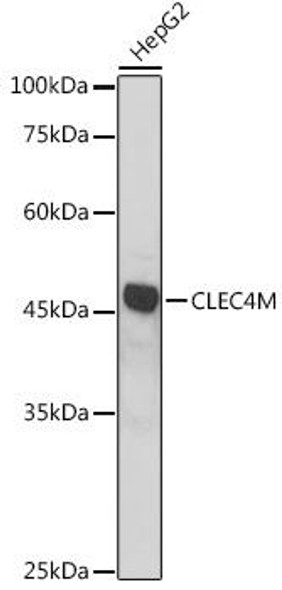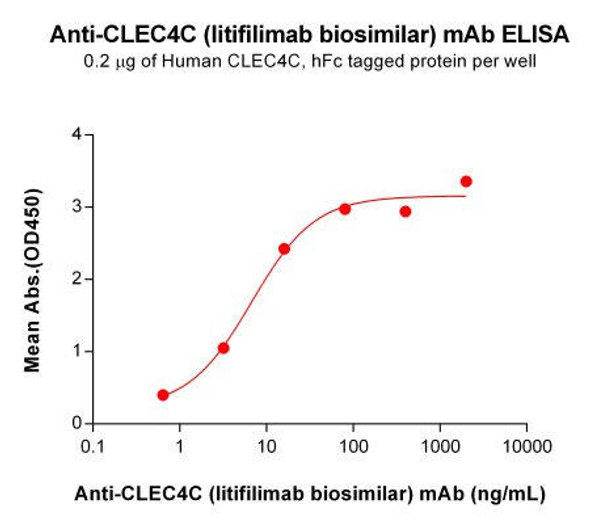Description
| Product Name: | CLEC4E Rabbit pAb |
| Product Code: | CAB20156 |
| Size: | 50uL, 100uL |
| Synonyms: | MINCLE, CLECSF9 |
| Applications: | WB |
| Reactivity: | Mouse, Rat |
| Host Species: | Rabbit |
| Immunogen: | Recombinant protein of human CLEC4E. |
| Applications: | WB |
| Recommended Dilutions: | WB 1:1000 - 1:2000 |
| Reactivity: | Mouse, Rat |
| Positive Samples: | Mouse spleen, Rat spleen |
| Immunogen: | Recombinant protein of human CLEC4E. |
| Purification Method: | Affinity purification |
| Storage: | Store at -20°C. Avoid freeze / thaw cycles. Buffer: PBS with 0.02% sodium azide, 50% glycerol, pH7.3. |
| Isotype: | IgG |
| Sequence: | Email for sequence |
| Gene ID: | 26253 |
| Uniprot: | Q9ULY5 |
| Calculated MW: | 25kDa |
| Observed MW: | 27KDa |
| UniProt Protein Function: | CLEC4E: C-type lectin that functions as cell-surface receptor for a wide variety of ligands such as damaged cells, fungi and mycobacteria. Plays a role in the recognition of pathogenic fungi, such as Candida albicans. The detection of mycobacteria is via trehalose 6,6'-dimycolate (TDM), a cell wall glycolipid. Specifically recognizes alpha-mannose residues on pathogenic fungi of the genus Malassezia. Recognizes also SAP130, a nuclear protein, that is released by dead or dying cells. Transduces signals through an ITAM-containing adapter protein, Fc receptor gamma chain /FCER1G. Induces secretion of inflammatory cytokines through a pathway that depends on SYK, CARD9 and NF-kappa-B. |
| UniProt Protein Details: | Protein type:Membrane protein, integral; Receptor, misc. Chromosomal Location of Human Ortholog: 12p13.31 Cellular Component: integral to membrane; plasma membrane Molecular Function:carbohydrate binding; receptor activity Biological Process: defense response to bacterium; innate immune response; positive regulation of cytokine secretion; stimulatory C-type lectin receptor signaling pathway; T cell differentiation during immune response |
| NCBI Summary: | This gene encodes a member of the C-type lectin/C-type lectin-like domain (CTL/CTLD) superfamily. Members of this family share a common protein fold and have diverse functions, such as cell adhesion, cell-cell signalling, glycoprotein turnover, and roles in inflammation and immune response. The encoded type II transmembrane protein is a downstream target of CCAAT/enhancer binding protein (C/EBP), beta (CEBPB) and may play a role in inflammation. Alternative splice variants have been described but their full-length sequence has not been determined. This gene is closely linked to other CTL/CTLD superfamily members on chromosome 12p13 in the natural killer gene complex region. [provided by RefSeq, Jul 2008] |
| UniProt Code: | Q9ULY5 |
| NCBI GenInfo Identifier: | 7657333 |
| NCBI Gene ID: | 26253 |
| NCBI Accession: | NP_055173.1 |
| UniProt Secondary Accession: | Q9ULY5,B2R6Q6, |
| UniProt Related Accession: | Q9ULY5 |
| Molecular Weight: | 25,073 Da |
| NCBI Full Name: | C-type lectin domain family 4 member E |
| NCBI Synonym Full Names: | C-type lectin domain family 4 member E |
| NCBI Official Symbol: | CLEC4E |
| NCBI Official Synonym Symbols: | MINCLE; CLECSF9 |
| NCBI Protein Information: | C-type lectin domain family 4 member E |
| UniProt Protein Name: | C-type lectin domain family 4 member E |
| UniProt Synonym Protein Names: | C-type lectin superfamily member 9; Macrophage-inducible C-type lectin |
| Protein Family: | C-type lectin domain family |
| UniProt Gene Name: | CLEC4E |
| UniProt Entry Name: | CLC4E_HUMAN |


![CLEC4E Monoclonal Antibody [PAT16E3AT] (CPAB0431) CLEC4E Monoclonal Antibody [PAT16E3AT] (CPAB0431)](https://cdn11.bigcommerce.com/s-rd6ounxcu2/images/stencil/590x590/products/58653/63835/clec4e-monoclonal-antibody-pat16e3at-cpab0431__75813__42384.1706535172.jpg?c=1)



